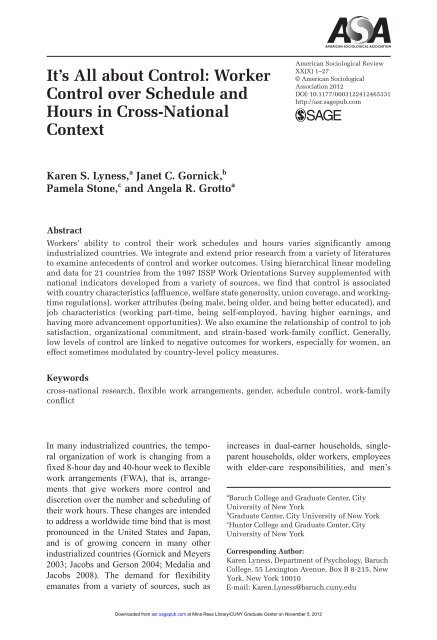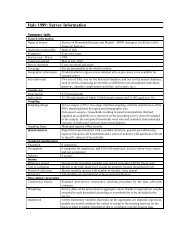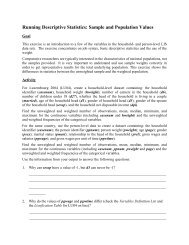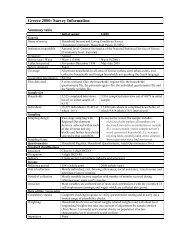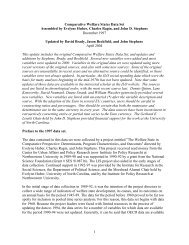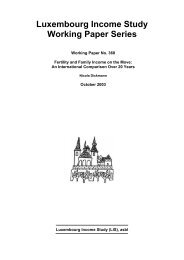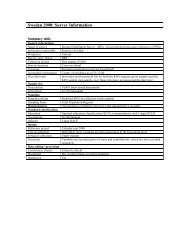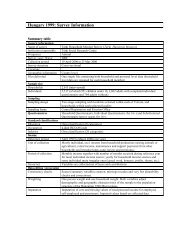It's All about Control: Worker Control over Schedule and Hours ... - LIS
It's All about Control: Worker Control over Schedule and Hours ... - LIS
It's All about Control: Worker Control over Schedule and Hours ... - LIS
- No tags were found...
Create successful ePaper yourself
Turn your PDF publications into a flip-book with our unique Google optimized e-Paper software.
6 American Sociological Review XX(X)have found schedule control to have no effecton work-life outcomes (Thompson <strong>and</strong> Prottas2006; Voydanoff 2004). These inconsistentresults suggest the need for further study.Consequences of Flexibility:Comparative Research on ContextualInfluencesSeveral comparative studies explore the influenceof a country’s gender egalitarian culture<strong>and</strong> policy environment on workers’ worklifeconflict <strong>and</strong> similar constructs (e.g.,Lyness <strong>and</strong> Kropf 2005). Generally, within<strong>and</strong> across European countries, women <strong>and</strong>men who work longer hours, hold dem<strong>and</strong>ingjobs, <strong>and</strong> have younger children are morelikely to report WFC or lower work-life balance(Cousins <strong>and</strong> Tang 2004; Lyness <strong>and</strong>Kropf 2005; Ruppanner 2011; van der Lippe,Jager, <strong>and</strong> Kops 2006). Schieman <strong>and</strong> colleagues(2009) found similar results in theUnited States. At the country level, however,results are surprising, with most researchshowing that parents in countries with themost egalitarian gender roles <strong>and</strong> highly supportivework-family policies—such asSweden—report more, not less, work-conflictthan do parents in countries with less generouswork-family policies, such as theAnglophone <strong>and</strong> Eastern European bloccountries (Cousins <strong>and</strong> Tang 2004; Crompton<strong>and</strong> Lyonette 2006; Str<strong>and</strong>h <strong>and</strong> Nordenmark2006; van der Lippe et al. 2006). In trying tomake sense of this seemingly anomalousresult, scholars have suggested that more progressivegender norms may actually heightenwork-family conflict by increasing pressuresfor men <strong>and</strong> women to be involved in bothwork <strong>and</strong> family spheres. In contrast to thisprevailing pattern, Ruppanner’s (2011) recentmultilevel study of 10 Western countriesfound that work-family policies appear tomodulate WFC only for women who are parentsof young children. With regard to influenceson work-family conflict, the surprising<strong>and</strong> contradictory results of prior research,based on a relatively small number of countries,also suggest the need for further study.Model And HypothesesWe estimate a multilevel model of workplaceflexibility or, as we conceptualize it, workercontrol <strong>over</strong> working time, defined as control<strong>over</strong> one’s work schedule <strong>and</strong> hours. Ourmodel includes micro-level worker <strong>and</strong> jobcharacteristics that research shows are associatedwith flexibility. Our model also includeseffects of several country-level factors identifiedin the small prior cross-national literature<strong>about</strong> contextual antecedents of workers’flexibility. These include macroeconomic factors,labor market characteristics, <strong>and</strong> policyindicators related to social spending <strong>and</strong> regulationof working time. In light of claimsmade <strong>about</strong> the beneficial consequences ofworkers’ control <strong>over</strong> their working time, wealso evaluate the impact of our flexibilitymeasures on three crucial policy-relevant outcomes.Figure 1 shows our model, whichassesses both antecedents <strong>and</strong> consequencesof worker control <strong>over</strong> working time.At the micro-level, based on the foregoingliterature review, we hypothesize that womenwill have less flexibility or control. Wehypothesize that age, education, <strong>and</strong> having apartner will all be positively linked to workercontrol. We also include micro-level job characteristics<strong>and</strong> hypothesize that working fulltimewill result in less control than workingpart-time, but that being self-employed orworking in exempt, high-paying jobs withopportunities for advancement will result inmore control.At the country level, we examine effects ofmany salient aspects of national context,including st<strong>and</strong>ard of living (GDP per capita),public social welfare effort (measured bysocial expenditures), <strong>and</strong> characteristics ofthe labor force (women’s labor force participation,service sector employment, <strong>and</strong> unionc<strong>over</strong>age). We hypothesize that all thesemacro-level contextual features will be positivelyassociated with worker control. Wealso include two measures of working timeregulation: length of the st<strong>and</strong>ard work week(in hours) <strong>and</strong> amount of paid leave grantedannually (in days). Both directly affect theDownloaded from asr.sagepub.com at Mina Rees Library/CUNY Graduate Center on November 5, 2012
8 American Sociological Review XX(X)decided by my employer; 2 = I can decide thetime I start <strong>and</strong> finish work, within certainlimits; 3 = I am entirely free to decide when Istart <strong>and</strong> finish work). We measured control<strong>over</strong> work hours with two new variablesderived from an ISSP item that asked <strong>about</strong>preference for time in a paid job using a fivepointscale (1 = much more time to 5 = muchless time). We collapsed the five responseoptions <strong>and</strong> created two dichotomous variablesreflecting different types of hoursmismatch: (1) hours deficit, that is, workerpreference for more work hours (coded 1 =hours deficit; 0 = no deficit, worker preferencefor same or fewer hours) <strong>and</strong> (2) hours excess,that is, worker preference for fewer workhours (coded 1 = hours excess; 0 = no excess,preference for same or more work hours).<strong>Worker</strong> outcome variables. Work-familyconflict (WFC) occurs when work interfereswith performance of nonwork roles; strainbasedconflict, an important type of WFC,occurs when work-related strain or fatigueinterferes with a nonwork role (Greenhaus <strong>and</strong>Beutell 1985). We measured strain-based conflictwith the ISSP item: “How often do youcome home from work exhausted?” (1 = neverto 5 = always). We measured job satisfactionwith the ISSP item: “How satisfied are you inyour job?” (1 = completely dissatisfied to 7 =completely satisfied). We measured organizationalcommitment by averaging two ISSPitems: (1) “I am willing to work harder than Ihave to in order to help the organization or firmI work for succeed” <strong>and</strong> (2) “I am proud to beworking for my firm or organization” (1 =strongly disagree to 5 = strongly agree). Thealpha coefficient for the scale was .65.<strong>Worker</strong> characteristics. <strong>Worker</strong> characteristicsincluded gender, coded as female (0 =no, 1 = yes), age (between 25 <strong>and</strong> 54 years),education measured in years, <strong>and</strong> partneredstatus (i.e., married/living with partner; 0 =no, 1 = yes).Job characteristics. Job characteristicsincluded full-time work status (0 = no, 1 = yes)<strong>and</strong> self-employment (0 = no, 1 = yes). We alsoincluded two characteristics associated withdesirable jobs, measured as the extent to whichthese characteristics described respondents’current jobs: high earnings (1 = strongly disagreeto 5 = strongly agree) <strong>and</strong> high opportunityfor advancement (1 = strongly disagree to 5 =strongly agree). Earnings <strong>and</strong> advancementopportunity, along with workers’ education,capture various aspects of social class, as wewill discuss later. Data <strong>about</strong> weekly hoursworked were available for only 20 countries(data not available for New Zeal<strong>and</strong>) <strong>and</strong> wereused for supplementary analyses.National characteristics. Data are from1997, the first year of individual-level datacollection, unless otherwise noted. Weobtained gross domestic product (GDP) percapita (adjusted for purchasing power parity<strong>and</strong> measured in current dollars) from theUnited Nations (United Nations StatisticsDivision 1995). Social expenditure, whichmeasures public social welfare spending as apercentage of GDP, comes from the OECDFact Book 2007 (Organization for EconomicCooperation <strong>and</strong> Development 2007), anotherOECD source for Russia (Organization forEconomic Cooperation <strong>and</strong> Development2001), <strong>and</strong> an ILO source for Slovenia (1991),Bulgaria (1996), <strong>and</strong> Hungary (ILO Departmentof Statistics 1997a).Women’s labor force participation rateswere reported in an OECD statistical annex(Organization for Economic Cooperation <strong>and</strong>Development 1997); for Bulgaria, Russia,<strong>and</strong> Slovenia, data come from the World BankGenderStats database (World Bank KeyDevelopment Data & Statistics 2008). Wecomputed the percentage of employees workingin industries classified as belonging to theservice sector from a yearly statistical classificationof industries into agricultural, manufacturing,<strong>and</strong> service sectors. We obtaineddata from the ILO Department of StatisticsLaborsta database (ILO Department of Statistics1997b); data for Bulgaria (1996) <strong>and</strong>France (1999) come from the CIA WorldFactbook (Central Intelligence Agency 2007).Downloaded from asr.sagepub.com at Mina Rees Library/CUNY Graduate Center on November 5, 2012
Table 1. Means for <strong>Worker</strong> <strong>Control</strong> Variables <strong>and</strong> Outcome Variables by Gender within Country Groups<strong>Worker</strong> <strong>Control</strong> Variables <strong>Worker</strong> Outcome Variablesn<strong>Control</strong> Over<strong>Schedule</strong> <strong>Hours</strong> Excess <strong>Hours</strong> DeficitStrain-BasedWork-FamilyConflict Job SatisfactionOrganizationalCommitmentGroup Male Female Male Female Male Female Male Female Male Female Male Female Male FemaleNordic 992 999 1.75 1.58 *** .52 .51 .06 .09 * 3.20 3.38 *** 5.34 5.36 3.66 3.62Continental European 1,691 1,413 1.72 1.67 * .47 .35 *** .10 .14 *** 3.19 3.27 ** 5.29 5.36 3.59 3.48 ***Southern European 729 507 1.63 1.48 *** .29 .31 .17 .19 3.40 3.56 ** 5.28 5.14 * 3.74 3.66Anglophone 699 764 1.65 1.59 .43 .48 .14 .15 3.33 3.42 * 5.14 5.29 * 3.78 3.80Eastern European 1,316 1,211 1.50 1.36 *** .25 .28 .25 .21 ** 3.45 3.53 * 4.99 5.01 3.45 3.41Asian/Pacific Rim 225 141 1.50 1.28 ** .51 .42 .04 .09 3.24 3.21 4.67 4.70 3.78 3.48 **Note: Significant gender differences within each cluster, based on two-tailed t-tests, are indicated.* p < .05; ** p < .01; *** p < .001.10Downloaded from asr.sagepub.com at Mina Rees Library/CUNY Graduate Center on November 5, 2012
Table 2. Multilevel Analyses Predicting <strong>Control</strong> <strong>over</strong> <strong>Schedule</strong> with Individual- <strong>and</strong> Country-Level VariablesVariable Model 1 Model 2 Model 3 Model 4 Model 5 Model 6 Model 7 Model 8Individual-Level Fixed EffectsIntercept (γ 00) 1.577 ***(.031)<strong>Worker</strong> CharacteristicsFemale (γ 10) –.033 *(.015)Age (γ 20) .004 **(.001)Years of Education (γ 30) .026 ***(.003)Partnered (γ 40) .023(.015)Job CharacteristicsFull-Time (γ 50) –.086 *(.036)Self-Employment (γ 60) .906 ***(.058)High Earnings (γ 70) .068 ***(.008)High Opportunity for Advancement (γ 80) .049 ***(.011)1.409 ***(.049)–.033 *(.015).004 **(.001).026 ***(.003).025(.015)–.085 *(.036).904 ***(.059).069 ***(.009).049 ***(.011)1.281 ***(.076)–.033 *(.016).004 **(.001).027 ***(.002).025(.015)–.085 *(.036).904 ***(.058).069 ***(.009).049 ***(.011)1.332 ***(.104)–.033 *(.015).004 **(.001).026 ***(.003).025(.015)–.085 *(.036).903 ***(.059).069 ***(.009).049 ***(.011)1.411 ***(.144)–.034 *(.015).004 **(.001).026 ***(.003).025(.015)–.085 *(.036).904 ***(.059).069 ***(.009).049 ***(.011)1.310 ***(.068)–.033 *(.015).004 **(.001).027 ***(.003).025(.015)–.085 *(.036).905 ***(.058).068 ***(.009).050 ***(.011).714(.589)–.033 *(.015).004 **(.001).026 ***(.002).025(.015)–.085 *(.037).904 ***(.058).069 ***(.009).049 ***(.011).734(.597).015(.378).004 **(.000).026 ***(.002).025(.012)–.085 *(.034).904 ***(.057).069 ***(.008).049 ***(.011)Country-Level Fixed EffectsIntercept x GDP per Capita (γ 01) .009 **.007 **(.002)(.002)Intercept x Social Expenditure (γ 02) .007 *Intercept x Women’s Labor ForceParticipation Rate (γ 02)Intercept x Service Sector (γ 02) –.006(.314)Intercept x Union C<strong>over</strong>age (γ 02) .220 *(.003).008 *(.003).002(.002).009 *(.002).007 **(.002)(.078).010 ***(.002).010 **(.002)(continued)12Downloaded from asr.sagepub.com at Mina Rees Library/CUNY Graduate Center on November 5, 2012
Table 2. (continued)Variable Model 1 Model 2 Model 3 Model 4 Model 5 Model 6 Model 7 Model 8Intercept x Weekly <strong>Hours</strong> Policy (γ 02) .014(.014)Intercept x Paid Leave Policy (γ 03) .006 *Female Slope x GDP per Capita (γ 11) –.000(.002)Female Slope x Weekly <strong>Hours</strong> Policy (γ 12) –.001(.009)Female Slope x Paid Leave Policy (γ 13) .000(.001)(.003).014(.014).006(.003)Intercept R<strong>and</strong>om Effect (μ ) .020 *** .013 *** .011 *** .012 *** .013 *** .013 *** .012 *** .012 ***10Female Slope R<strong>and</strong>om Effect (μ ) .002 .002Note: Entries are unst<strong>and</strong>ardized coefficients; st<strong>and</strong>ard errors are in parentheses. N = 21 countries. GDP = gross domestic product. Gross domestic product percapita was measured in thous<strong>and</strong>s.* p < .05; ** p < .01; *** p < .001 (two-tailed tests).13Downloaded from asr.sagepub.com at Mina Rees Library/CUNY Graduate Center on November 5, 2012
Table 3. Multilevel Analyses Predicting <strong>Hours</strong> Excess with Individual- <strong>and</strong> Country-Level VariablesVariable Model 1 Model 2 Model 3 Model 4 Model 5 Model 6 Model 7 Model 8Individual-Level Fixed EffectsIntercept (γ 00) .562 **(–3.666)<strong>Worker</strong> CharacteristicsFemale (γ 10) 1.232 **(2.961)Age (γ 20) 1.004(1.026)Years of Education (γ 30) 1.056 ***(6.270)Partnered (γ 40) 1.078(.960)Job CharacteristicsFull-Time (γ 50) 3.232 ***(7.104)Self-Employment (γ 60) 1.030(.275)High Earnings (γ 70) 1.019(.506)High Opportunity forAdvancement (γ 80).905 **(–3.734).201 ***(–6.006)1.230 **(2.896)1.004(1.176)1.055 ***(6.171)1.099(1.215)3.454 ***(7.452)1.022(.204)1.016(.420).906 **(–3.643).109 ***(–5.222)1.230 **(2.891)1.004(1.178)1.054 ***(6.178)1.103(1.265)3.485 ***(7.403)1.026(.240)1.016(.418).905 **(–3.646).056 ***(–5.745)1.231 **(2.898)1.005(1.218)1.055 ***(6.215)1.102(1.285)3.462 ***(7.296)1.013(.119)1.012(.340).906 **(–3.614).028 ***(–4.844)1.231 *(2.890)1.005(1.281)1.055 ***(6.273)1.102(1.264)3.500 ***(7.640)1.011(.100)1.016(.404).904 **(–3.603).201 **(–3.985)1.230 **(2.895)1.004(1.179)1.055 ***(6.153)1.099(1.228)3.458 ***(7.462)1.022(.205)1.016(.415).906 **(–3.646).004(–1.629)1.223 *(2.785)1.004(1.204)1.055 ***(6.198)1.103(1.266)3.521 ***(7.530)1.022(.207)1.012(.319).906 **(–3.567).002(–1.841)7.970(1.040)1.004(1.201)1.056 ***(6.234)1.093(1.131)3.531 ***(7.560)1.022(.208)1.010(.261).907 **(–3.502)Country-Level Fixed EffectsIntercept x GDP per Capita (γ 01) 1.054 ***(4.355)1.052 ***(4.349)Intercept x Social Expenditure (γ 02) 1.032(1.754)Intercept x Women’s Labor ForceParticipation Rate (γ 02)1.016(1.107)1.033 **(3.108)1.017(.886)Intercept x Service Sector (γ 02) 68.128 *(2.648)Intercept x Union C<strong>over</strong>age (γ 02) .982(–.040)1.054 **(4.239)1.065 ** *(4.499)1.066 ***(4.575)(continued)14Downloaded from asr.sagepub.com at Mina Rees Library/CUNY Graduate Center on November 5, 2012
Table 3. (continued)Variable Model 1 Model 2 Model 3 Model 4 Model 5 Model 6 Model 7 Model 8Intercept x Weekly <strong>Hours</strong> Policy (γ 02) 1.080(.964)Intercept x Paid Leave Policy (γ 03) 1.035 *Female Slope x Gross DomesticProduct per Capita (γ 11)Female Slope x Weekly <strong>Hours</strong>Policy (γ 12)Female Slope x Paid LeavePolicy (γ 13)(2.181)1.097(1.175)1.036 *(2.223).990(–1.194).970(–.636).975 *(–2.725)Intercept R<strong>and</strong>om Effect (μ ) .507 *** .310 *** .256 *** .231 *** .281 *** .319 *** .318 *** .321 ***10Female Slope R<strong>and</strong>om Effect (μ ) .056 ** .042 *Note: Entries are odds ratios (<strong>and</strong> t-ratios) from unit-specific models. N = 21 countries. GDP = gross domestic product. Gross domestic product per capita wasmeasured in thous<strong>and</strong>s.* p < .05; ** p < .01; *** p < .001 (two-tailed tests).15Downloaded from asr.sagepub.com at Mina Rees Library/CUNY Graduate Center on November 5, 2012
16 American Sociological Review XX(X)job characteristics, full-time work has a positiverelationship to hours excess <strong>and</strong> opportunitiesfor advancement has a negative relationship;the nonsignificant r<strong>and</strong>om effect suggests thatthe advancement opportunities relationship doesnot vary across countries. 1GDP per capita has a significant positiverelationship to hours excess (Table 3, Model2). Holding constant the other predictors <strong>and</strong>the r<strong>and</strong>om effect, for every $1,000 increase inGDP per capita, the expected odds that arespondent would report hours excessincreases by <strong>about</strong> 5 percent. <strong>Control</strong>ling forGDP per capita, women’s labor force participation<strong>and</strong> service sector employment havepositive relationships to hours excess (Models4 <strong>and</strong> 5). Also, GDP per capita in combinationwith each of these characteristics reduces thecross-national r<strong>and</strong>om effects for the modelintercept by approximately half, <strong>and</strong> thusexplains meaningful cross-national variationin workers’ reported hours excess. Neithersocial expenditure nor union c<strong>over</strong>age is asignificant predictor (Models 3 <strong>and</strong> 6).Of the two policy variables, paid leavepolicy has a significant positive relationshipto hours excess, but weekly work hours policyis not significantly related (Model 7).Also, paid leave policy has a significant negativemoderating effect on the micro-levelrelationship between gender <strong>and</strong> hours excess,such that the <strong>over</strong>all gender relationship is nolonger significant when paid leave policiesare taken into account (Model 8). The gendergap thus varies depending on paid leave policies;in countries with more generous paidleave policies (e.g., Sweden with 25 days),women are more similar to their male counterpartsin likelihood of reporting an hoursexcess, whereas in countries with less generousleave policies (the United States being theextreme with no guaranteed leave) there is alarger gender gap, with women more likelythan men to report an hours excess.<strong>Control</strong> <strong>over</strong> hours: hours deficit. We alsoused HGLM to estimate multilevel logisticmodels for hours deficit (worker preference formore work hours). Based on a model with nopredictors, the estimated log odds of reportingan hours deficit (γ 00) = –1.838 (SE = .159),which corresponds to a probability of .137.Of the worker characteristics, women <strong>and</strong>workers with partners (married or living asmarried) were less likely to report an hoursdeficit than were men or workers without partners(Table 4, Model 1). Based on its r<strong>and</strong>omeffect, the relationship of gender to hours deficitdoes not vary significantly across countries.Three job characteristics are significantlyrelated to hours deficit (Model 1): full-timework <strong>and</strong> high income work have negativerelationships to hours deficit, <strong>and</strong> being selfemployedis positively related. 2 Only the relationshipwith self-employment does not appearto vary significantly across countries.GDP per capita has a negative relationshipto hours deficit (Table 4, Model 2). The oddsratio indicates that holding constant the otherpredictors <strong>and</strong> the r<strong>and</strong>om effect, for every$1,000 increase in GDP per capita, theexpected odds that a respondent would reportan hours deficit decrease by <strong>about</strong> 7 percent.After controlling for GDP per capita, socialexpenditure <strong>and</strong> women’s labor force participationhave significant negative relationshipsto hours deficit (Models 3 <strong>and</strong> 4). GDP percapita, as well as GDP per capita in combinationwith these other two national characteristics,reduce the cross-national r<strong>and</strong>om effectsfor the intercept by <strong>over</strong> one-third, <strong>and</strong> thusexplain meaningful cross-national variationin workers’ reported hours deficit. Servicesector proportion <strong>and</strong> union c<strong>over</strong>age are notsignificant predictors (Models 5 <strong>and</strong> 6).Of the two policy variables (Model 7),paid leave policy has a negative relationshipto hours deficit, but weekly hours policy isnot significantly related. Both paid leave policy<strong>and</strong> weekly hours policy are significantpositive moderators of the relationshipbetween gender <strong>and</strong> hours deficit. After controllingfor effects of these interactions, therelationship between gender <strong>and</strong> hours deficitis weaker but still statistically significant.Tests of gender differences. To see ifrelationships of worker <strong>and</strong> job characteristicsDownloaded from asr.sagepub.com at Mina Rees Library/CUNY Graduate Center on November 5, 2012
Table 4. Multilevel Analyses Predicting <strong>Hours</strong> Deficit with Individual- <strong>and</strong> Country-Level VariablesVariable Model 1 Model 2 Model 3 Model 4 Model 5 Model 6 Model 7 Model 8Individual-Level Fixed EffectsIntercept (γ 00) .134 ***(–11.353)<strong>Worker</strong> CharacteristicsFemale (γ 10) .699 ***(–4.491)Age (γ 20) .993(–1.452)Years of Education (γ 30) .968(–1.797)Partnered (γ 40) .795 *(–2.394)Job CharacteristicsFull-Time (γ 50) .248 ***(–7.909)Self-Employment (γ 60) 1.446 **(3.331)High Earnings (γ 70) .861 **(–2.921)High Opportunity forAdvancement (γ 80)1.040(1.069).511 *(–2.425).703 ***(–4.412).993(–1.320).968(–1.817).795 *(–2.350).243 ***(–8.277)1.444 **(3.356).868 *(–2.837)1.038(1.009)1.423(.831).706 ***(–4.364).993(–1.279).968(–1.761).793 *(–2.375).244 ***(–8.310)1.438 **(3.326).868 *(–2.771)1.038(1.019)1.468(.667).700 ***(–4.456).993(–1.326).968(–1.793).798 *(–2.324).242 ***(–8.312)1.435 **(3.288).867 *(–2.861)1.038(1.021).823(–.227).703 ***(–4.403).993(–1.303).968(–1.797).795 *(–2.367).242 ***(–8.324)1.438 **(3.316).868 *(–2.801)1.038(1.011).540(–1.401).704 ***(–4.402).993(–1.327).968(–1.816).795 *(–2.351).243 ***(–8.280)1.443 **(3.347).868 *(–2.830)1.038(1.009)210.905(1.418).697 ***(–4.526).993(–1.243).968(–1.768).784 *(–2.521).240 ***(–8.325)1.450 **(3.393).869 *(–2.802)1.042(1.130)8.929(.619).000 *(–2.910).994(–1.254).968(–1.761).780 *(–2.503).238 ***(8.406)1.451 **(3.460).866 *(–2.848)1.043(1.166)Country-Level Fixed EffectsIntercept x GDP per Capita (γ 01) .934 ***.937 ***(–5.821)(–5.566)Intercept x Social Expenditure (γ 02) .949 *Intercept x Women’s Labor ForceParticipation Rate (γ 02)(–2.748).959 *(–2.562).975 *(–2.102).943 *(–2.615).933 ***(–5.481)Intercept x Service Sector (γ 02) .356(–.552)Intercept x Union C<strong>over</strong>age (γ 02) .946(–.104).921 ***(–6.001).923 ***(–6.193)(continued)17Downloaded from asr.sagepub.com at Mina Rees Library/CUNY Graduate Center on November 5, 2012
Table 4. (continued)Variable Model 1 Model 2 Model 3 Model 4 Model 5 Model 6 Model 7 Model 8Intercept x Weekly <strong>Hours</strong> Policy (γ 02) .883(–1.381)Intercept x Paid Leave Policy (γ 03) .955 *Female Slope x Gross DomesticProduct per Capita (γ 11)Female Slope x Weekly <strong>Hours</strong>Policy (γ 12)(–2.838).951(–.598).967 *(–2.158)Female Slope x Paid Leave Policy (γ 13) 1.027 *1.003(.348)1.201 *(2.738)(2.348)Intercept R<strong>and</strong>om Effect (μ ) .628 *** .392 *** .320 *** .344 *** .398 *** .402 *** .351 *** .345 ***10Female Slope R<strong>and</strong>om Effect (μ ) .036 .024Note: Entries are odds ratios (<strong>and</strong> t-ratios) from unit-specific models. N = 21 countries. GDP = gross domestic product. Gross domestic product per capita wasmeasured in thous<strong>and</strong>s.* p < .05; ** p < .01; *** p < .001 (two-tailed tests).18Downloaded from asr.sagepub.com at Mina Rees Library/CUNY Graduate Center on November 5, 2012
Lyness et al. 19to the three types of control <strong>over</strong> working timediffer by gender, we conducted additionalmicro analyses with main effects for gender<strong>and</strong> the seven micro characteristics, as well asinteractions of gender with each characteristic.We found little evidence that relationshipsdiffer by gender (results not shown here).None of the gender interactions predictinghours excess or hours deficit are significant.For schedule control, however, there is onenotable exception: the gender by educationinteraction. Examination of separate level-lmodels for each gender reveals that, althougheducation has a significant positive relationshipto schedule control for both genders, therelationship is somewhat stronger for menthan for women, indicating that men reportedslightly more schedule control for each additionalyear of education than did women. 3Social class comparisons. A final set ofexploratory analyses examined whether thethree types of control differ depending onworker social class, based on a self-reportedmeasure of social class that was available foronly 19 countries; data were missing for theUnited Kingdom <strong>and</strong> Hungary. (These exploratoryanalyses, which rely on subjectiveassessments of class, supplement our findingsreported above, based on three other indicatorsthat capture facets of class [i.e., education<strong>and</strong> jobs with high earnings or advancementopportunities]). Because the social class measurehad different response options acrosscountries, we aggregated responses into threecategories: below middle class, middle class,<strong>and</strong> above middle class, <strong>and</strong> created twodichotomous variables: (1) lower class (1 =below middle class, 0 = middle class or above)<strong>and</strong> (2) upper class (1 = above middle class, 0= middle class or below). We conductedlevel-1 analyses that included the two socialclass variables, controlling for the other eightmicro characteristics (not shown).We found a significant negative relationshipbetween the measure of lower class <strong>and</strong> schedulecontrol; lower class workers reported lessschedule control than did workers from middleor upper classes, <strong>and</strong> the nonsignificant r<strong>and</strong>omeffect suggests that the relationship is invariantacross the 19 countries. 4 Consistent with findingthat lower class workers have less schedulecontrol, the other class-related indicators (education,high earnings, <strong>and</strong> advancement opportunities)all have positive relationships toschedule control. The lower class measure isalso positively related to an hours deficit, indicatingthat lower class workers were more likelyto report this type of hours mismatch than weremiddle- or upper-class workers. Among theother class indicators, only high earnings has asignificant negative relationship to hours deficit.The lower social class measure is not related tohours excess, <strong>and</strong> two other class indicatorshave inconsistent relationships, with a positiverelationship for education <strong>and</strong> a negative relationshipfor advancement opportunities. Theupper-class measure is not significantly relatedto any of the three control measures, suggestingthat, after controlling for the eight individuallevelworker <strong>and</strong> job characteristics, control<strong>over</strong> schedule <strong>and</strong> working time do not differbetween upper- <strong>and</strong> middle-class workers.Multilevel Analyses: Consequences of<strong>Worker</strong> <strong>Control</strong> <strong>over</strong> Working TimeIn the next set of analyses, we test the consequencesof worker control by examining microlevelrelationships of each type of workercontrol to the three outcome variables, controllingfor the eight worker <strong>and</strong> job characteristics(see Table 5). We used HLM analyses to testthese relationships, <strong>and</strong> to determine whetherthe relationships hold across countries.<strong>Worker</strong> schedule control is positivelyrelated to both job satisfaction <strong>and</strong> organizationalcommitment. More<strong>over</strong>, the nonsignificantr<strong>and</strong>om effects for these two relationshipssuggest a lack of meaningful cross-nationalvariation. <strong>Schedule</strong> control is not significantlyrelated to strain-based WFC for thetotal sample but, as we will discuss later, therelationship is significant for female workers.<strong>Hours</strong> excess has significant relationshipsto all three outcomes, with a positive relationshipto strain-based WFC, <strong>and</strong> negative relationshipsto job satisfaction <strong>and</strong> organizationalDownloaded from asr.sagepub.com at Mina Rees Library/CUNY Graduate Center on November 5, 2012
20 American Sociological Review XX(X)Table 5. Multilevel Analyses Predicting Strain-Based Work-Family Conflict, Job Satisfaction,<strong>and</strong> Organizational Commitment with <strong>Control</strong> <strong>over</strong> <strong>Schedule</strong>, <strong>Hours</strong> Excess, <strong>and</strong> <strong>Hours</strong>DeficitVariable (1) Strain-Based WFC (2) Job Satisfaction(3) OrganizationalCommitmentFixed Effect<strong>Control</strong> <strong>over</strong> <strong>Schedule</strong> (γ 90) –.032(.021).122 ***(.016).125 ***(.016)<strong>Hours</strong> Excess (γ 90) .233 ***(.019)–.284 ***(.030)–.156 ***(.025)<strong>Hours</strong> Deficit (γ 90) –.074 *(.031)–.028(.040).140 **(.037)R<strong>and</strong>om Effect<strong>Control</strong> <strong>over</strong> <strong>Schedule</strong> (μ 9) .005 ** .003 .001<strong>Hours</strong> Excess (μ 9) .001 .009 * .007 **<strong>Hours</strong> Deficit (μ 9) .008 * .013 .017 **Note: Entries are unst<strong>and</strong>ardized coefficients; st<strong>and</strong>ard errors are in parentheses. N = 21 countries.<strong>All</strong> three models control for individual-level effects of worker characteristics (gender, age, education,<strong>and</strong> partner) <strong>and</strong> job characteristics (full-time status, self-employed, high earnings, <strong>and</strong> advancementopportunities), but these coefficients are not shown.* p < .05; ** p < .01; *** p < .001 (two-tailed tests).commitment. The nonsignificant r<strong>and</strong>omeffect suggests that the relationship to strainbasedWFC does not vary across countries.<strong>Hours</strong> deficit has a negative relationship withstrain-based WFC <strong>and</strong> a positive relationshipto organizational commitment, but is not significantlyrelated to job satisfaction.Tests of gender differences. To see ifthese relationships differ by gender, werepeated these analyses <strong>and</strong> included interactionsof gender with each type of workercontrol (not shown). Seven of the nine interactionsare statistically significant; weexamined separate models by gender to clarifythe findings. Of particular note are ourfindings that, for women, control <strong>over</strong> workschedule has a significant negative relationshipto strain-based WFC, but this is not thecase for men. Women with more control <strong>over</strong>their work schedules thus reported less WFC,whereas for men it made no difference. Wealso found that actual weekly work hourswere related to schedule control for men butnot for women (not shown); this raises thepossibility that schedule control is negativelyrelated to strain-based WFC for women butnot men because men with schedule controlare working longer hours, as has been seen inthe United States. 5 However, adding a controlfor weekly work hours does not change ourpattern of gender results; schedule controlstill has a significant negative relationship tostrain-based WFC for women, <strong>and</strong> a nonsignificantrelationship for men (not shown).Among the three types of control, onlyhours excess shows a consistent pattern of genderdifferences across all three outcome measures,with stronger relationships for womenthan for men. For women, hours excess has astronger positive relationship to strain-basedWFC <strong>and</strong> stronger negative relationships to jobsatisfaction <strong>and</strong> organizational commitmentthan is the case for men. The other significantgender interactions reflect small gender differencesin effect sizes of relationships, but thedirections of these relationships are consistentwith (i.e., in the same direction as) results basedon the total sample (see Table 5).Social class comparisons. We also conductedexploratory micro analyses thatDownloaded from asr.sagepub.com at Mina Rees Library/CUNY Graduate Center on November 5, 2012
Lyness et al. 21included interactions of the two social classmeasures with each type of worker control tosee if social class moderates relationshipswith the three worker consequences (notshown). None of these interaction terms arestatistically significant, suggesting that therelationships of control to worker consequencesdo not differ according to workers’social class.DiscussionCountry-Level Influences <strong>and</strong> <strong>Worker</strong><strong>Control</strong> <strong>over</strong> Working TimeOur study considerably extends prior researchto document the importance of country contextin underst<strong>and</strong>ing workers’ control <strong>over</strong>work schedules <strong>and</strong> hours, independent of themore often studied effects of individual characteristics<strong>and</strong> job features. Our multilevel,multivariate analyses enable us to look insidethe black box of country to begin to underst<strong>and</strong>which country-level features affect control.For example, Nordic countries st<strong>and</strong> outas having, on average, the highest per capitaGDP, public social expenditure, <strong>and</strong> women’slabor force participation rates, <strong>and</strong> a comparativelylarge service sector, a relatively highunion c<strong>over</strong>age rate, <strong>and</strong> relatively short st<strong>and</strong>ardwork weeks—<strong>and</strong>, in general, morefavorable outcomes with respect to workers’control <strong>over</strong> their working time. In contrast,Eastern European countries have quite differentmacroeconomic <strong>and</strong> labor market features(including comparatively long st<strong>and</strong>ard workweeks) <strong>and</strong>, <strong>over</strong>all, less favorable workercontrol outcomes.Two intriguing findings emerge withregard to country-level influences. Factorsthat we typically interpret as indicators ofaffluence <strong>and</strong> economic independence forworkers are associated, as we predicted, withgreater control <strong>over</strong> starting <strong>and</strong> stoppingtimes (i.e., schedule control). Paradoxically,these same factors are also associated with agreater likelihood of workers’ reporting anhours excess, which we, in common withother researchers, have argued is a form ofmismatch <strong>and</strong> signals workers’ having lowerlevels of control. Higher per capita GDP,higher rates of women’s labor force participation,<strong>and</strong> a larger service sector are all associatedwith more widespread preferences forfewer hours, as are higher public socialexpenditures <strong>and</strong> more generous annual leavepolicies. <strong>All</strong> of these features are indicators ofvarious types of economic security for workers<strong>and</strong> their families, through greater householdincome or more widespread publicbenefits <strong>and</strong> services that provide alternativesto earned income, thus making shorter workhours more economically feasible. Here ourfindings support Reynolds (2004:94), whonoted that generous social policy “softens theconsequences of cutting back on one’s workhours,” <strong>and</strong> Stier <strong>and</strong> Lewin-Epstein(2003:320) who concluded that “in countrieswith a high rate of decommodification, workingmen <strong>and</strong> women prefer to reduce theirhours of work.” With regard to schedule control,our results also support <strong>and</strong> extend thoseof Berg <strong>and</strong> colleagues (2004) by empiricallydocumenting unions’ significant role in helpingworkers gain control <strong>over</strong> their workschedules, although not, we find, in addressinghours mismatch.Although generous welfare regimes mayindeed soften the economic consequences ofcutting back on hours, our findings of a linkbetween excess hours <strong>and</strong> negative workerconsequences raise questions <strong>about</strong> the abilityof even generous welfare regimes to offset thetime bind of long-hour jobs, many of whichare in service, managerial, <strong>and</strong> professionaloccupations that make up a growing share ofemployment in the countries studied. Themicro-level association of more educatedworkers <strong>and</strong> features of good jobs (advancementopportunities) with schedule control <strong>and</strong>hours excess highlights the emergence of aglobal pattern whereby workers, especiallymore elite workers, appear to have gainedcontrol <strong>over</strong> when they work at the expense ofhow long they work. This has negative consequencesfor these workers in the form ofincreased strain-based work-family conflict<strong>and</strong> less job satisfaction, as well as for theirDownloaded from asr.sagepub.com at Mina Rees Library/CUNY Graduate Center on November 5, 2012
22 American Sociological Review XX(X)employers in the form of less organizationalcommitment. This pattern of findings providesadditional support for what Schieman<strong>and</strong> colleagues (2009:970) identify in theUnited States as the “stress of higher status”hypothesis, in which high status, long-hourjobs increase work-family border permeability,making it harder, not easier, for workers tomanage work <strong>and</strong> family. Our results suggestthis phenomenon is widespread throughoutupper-income industrialized countries.The effects of working time policies aresomewhat surprising but might help explainthe foregoing paradox. The indicator that weexpected would have the stronger effect, thelength of the st<strong>and</strong>ard work week, is not significantlyassociated with any of the threecontrol measures, including the two that concernlack of control as reflected in hoursmismatch. This unexpected finding is probablydue to the limited variation on this indicator;the observed values across these 21countries ranged only from 37 to 40 hours. Incontrast, the generosity of paid leave policy isassociated with more schedule control, morehours excess, <strong>and</strong> less hours deficit. Theeffects of paid leave policy could operate in anumber of ways. Although we see no directlink to daily starting <strong>and</strong> stopping times, havingmore paid days off might contribute to aperception of having more control, becausepaid leave days are largely discretionary(workers can choose when to take them). Theassociation between more generous leavepolicy (which reduces hours spent at theworkplace <strong>over</strong> the course of the year) <strong>and</strong>hours excess (i.e., a preference for fewerhours) may arise partly due to a “social multipliereffect” (Alesina, Glaeser, <strong>and</strong> Sacerdote2005:4), such that workers will wantmore leisure time when family, friends, <strong>and</strong>colleagues have more leisure time or becausetime away from paid work is less stigmatized.Finally, more generous leave policies mightbe part of a larger package of more progressivegender policies, as in the Nordic countries.Although our analysis cannot identifythe specific policy mechanisms involved, theinvariant nature of the link between control<strong>and</strong> favorable employee/employer outcomesunderscores the benefits of policies, both public<strong>and</strong> private, that foster greater employeecontrol.Gender <strong>and</strong> <strong>Control</strong> <strong>over</strong> WorkingTimeA key contribution of our research is theexamination of the consequences of workershaving control <strong>over</strong> their time, which previouscross-national studies have not investigated.Underst<strong>and</strong>ing these consequences gives usinsight into whether increased worker controllives up to the claims made for it. Our answeris a qualified yes. We found that across allcountries, control <strong>over</strong> one’s work schedule ispositively related to job satisfaction <strong>and</strong> organizationalcommitment for both women <strong>and</strong>men, but it has a significant relationship tostrain-based WFC only for women, for whomgreater control results in reduced levels ofWFC. Although workers’ reported hours deficit(underwork) shows mixed outcomes, theirreported hours excess (an expression of <strong>over</strong>work)is consistently linked to negative outcomes:lower job satisfaction, less organizationalcommitment, <strong>and</strong> more strain-based WFC.Importantly, we generally found across countriesthat hours excess (<strong>over</strong>work) is linkedmore strongly for women than men to all threeof the micro-level consequences, suggestingthat lack of control <strong>over</strong> work hours hasgreater negative consequences for women,both in terms of the impact of work on theirlives outside of work <strong>and</strong> their attitudes <strong>about</strong>their jobs <strong>and</strong> organizations.Our results, which are consistent with findingsof gender differences in WFC from limitedprior comparative research (e.g., Moen<strong>and</strong> Forest 1990; Ruppanner 2011), makeclear that gender plays a significant role inworkers’ capacity to gain control <strong>over</strong> workingtime in industrialized economies—<strong>and</strong> towomen’s disadvantage. In juggling work <strong>and</strong>family, not only do women have less controlthan men <strong>over</strong> their starting <strong>and</strong> stoppingtimes, they are more likely to report <strong>over</strong>work,that is, they want to work fewer hours. We alsoDownloaded from asr.sagepub.com at Mina Rees Library/CUNY Graduate Center on November 5, 2012
Lyness et al. 23find that working part-time, other things beingequal, is associated with a desire for morehours, suggesting that women, who are morelikely to work part-time, fall back on lessdesirable part-time jobs to gain flexibility <strong>and</strong>an hours fit consonant with their personal <strong>and</strong>family dem<strong>and</strong>s (Bardasi <strong>and</strong> Gornick 2008;Crompton 1997; Stone 2007).Men, in contrast, have greater flexibilitywith respect to their starting <strong>and</strong> stoppingtimes <strong>and</strong> a lower likelihood of wanting fewerhours, that is, they are less likely to be workinglonger hours than desired. Although menmay be increasingly using these advantagesto shoulder more family responsibilities, ourresults also show that they are more likelythan women to desire more hours than theyhave, presumably to fulfill the traditionalmale breadwinner role. More<strong>over</strong>, in countrieswith higher rates of female labor forceparticipation, workers (both women <strong>and</strong> men)desire fewer hours, suggesting that in thesecountries workers are trying to relieve thefamily time bind—<strong>and</strong> that men may beshouldering more family responsibilities(Jacobs <strong>and</strong> Gerson 2004). In the process,men may be changing cultural attitudes bymaking shorter work hours more sociallyacceptable in their countries, complementingthe social multiplier effect discussed earlier.We thus discern three striking gender gapswith regard to control <strong>over</strong> working time. Thefirst is a schedule control gap such that women,who presumably need it more, have less controlthan men <strong>over</strong> their work schedules. The secondis an hours preference gap, reflecting a neotraditionalhousehold division of labor, whichfinds women unable to realize their preferencefor fewer hours <strong>and</strong> men unable to realize theirpreference for more. These gaps, in turn, areassociated with, <strong>and</strong> help create a third gap, thatwe call a work <strong>and</strong> family well-being gap,whereby women are less likely than men toexperience the favorable outcomes—enhancedjob satisfaction <strong>and</strong> organizational commitment<strong>and</strong> less strain-based WFC—associated with theability to control working time.Were women able to gain more schedulecontrol, our analysis suggests they wouldrealize attendant attitudinal <strong>and</strong> organizationalbenefits for themselves, their employers,<strong>and</strong> their families. Our results alsoindicate that public policies can moderatesome gender effects, <strong>and</strong> thus might hastenthe closing of some work-related gender gaps.In fact, after the time period c<strong>over</strong>ed in thisstudy, several of these countries enacted policiesthat explicitly grant workers more control<strong>over</strong> their work schedules or work hours(Hegewisch <strong>and</strong> Gornick 2008). Assessingthe impact of these policies, including theireffects on gendered divisions of labor in paid<strong>and</strong> unpaid work, should be a priority infuture research.FundingThis research was supported by grants from the CUNYCollaborative Research Program <strong>and</strong> the Alfred P. SloanFoundation.AcknowledgmentsWe gratefully acknowledge the able research assistanceof Meg Lovejoy, Kelsey Schwarz, Mary Ignagni, <strong>and</strong>Rebecca Ray. We also thank the ASR editors <strong>and</strong> ouranonymous reviewers for their insights <strong>and</strong> helpfulsuggestions.Notes1. We also tested the possibility that these relationshipsreflect effects of current work hours, with additionallevel-1 analyses (not shown) using weekly hoursworked in place of employment status (i.e., full-timeversus part-time). These two variables are related, r =.59, p < .001, but the work hours variable was availableonly for 20 countries (New Zeal<strong>and</strong> wasmissing). Consistent with the positive relationship tofull-time work, we found a positive relationshipbetween weekly hours worked <strong>and</strong> hours excess, oddsratio = 1.05, indicating that holding other predictors<strong>and</strong> the r<strong>and</strong>om effect constant, for each one-hourincrease in weekly work hours, the expected odds thata worker would report hours excess increases by<strong>about</strong> 5 percent. <strong>Control</strong>ling for hours worked, relationshipsof other variables to hours excess are similarto those based on full-time work (see Table 3, Model1). We thus conducted the remaining analyses usingthe full-time employment variable based on 21 countries<strong>and</strong> the larger sample.2. Based on the subset of respondents with data forweekly work hours, we also examined these relationshipsin a level-1 model that controlled for weeklyhours worked in place of full-time employmentDownloaded from asr.sagepub.com at Mina Rees Library/CUNY Graduate Center on November 5, 2012
24 American Sociological Review XX(X)status. The micro predictors all have similar relationshipsto hours deficit (not shown) as in the model withfull-time employment. We conducted the remaininganalyses using the full-time employment status variable<strong>and</strong> data from 21 countries.3. Based on the 18 countries with data <strong>about</strong> children, weconducted additional analyses with parental statusadded to level-l models estimated separately by gender.We found that living with children is not significantlyrelated to any of the three types of control <strong>over</strong> workingtime for either women or men (not shown).4. Research in the United States reports that workers’access to workplace benefits <strong>and</strong> rights, includingflexible work arrangements, is positively correlatedwith social class (see, e.g., Heymann 2001; Heymannet al. 2002; Williams <strong>and</strong> Boushey 2010). Our findingsare largely consistent with that claim, especiallywhen we assess the impact of being less than middleclass, according to self-report.5. We thank an anonymous reviewer for this insight.ReferencesAlesina, Alberto F., Edward L. Glaeser, <strong>and</strong> Bruce Sacerdote.2005. Work <strong>and</strong> Leisure in the U.S. <strong>and</strong> Europe:Why So Different? National Bureau of EconomicResearch. Cambridge, MA: MIT Press.<strong>All</strong>en, Tammy D. 2001. “Family-Supportive Work Environments:The Role of Organizational Perceptions.”Journal of Vocational Behavior 58:414–43.<strong>All</strong>en, Tammy D., David E. L. Herst, Carly S. Bruck, <strong>and</strong>Martha Sutton. 2000. “Consequences Associated withWork-to-Family Conflict: A Review <strong>and</strong> Agenda forFuture Research.” Journal of Occupational HealthPsychology 5:278–308.Baltes, Boris B., Thomas E. Brigg, Joseph W. Huff, JulieA. Wright, <strong>and</strong> George A. Neuman. 1999. “Flexible<strong>and</strong> Compressed Workweeks <strong>Schedule</strong>s: A Metaanalysisof Their Effects on Work-Related Criteria.”Journal of Applied Psychology 84:496–513.Bardasi, Elena <strong>and</strong> Janet C. Gornick. 2008. “Workingfor Less? Women’s Part-Time Wage Penalties acrossCountries.” Feminist Economics 14:37–72.Berg, Peter, Eileen Appelbaum, Tom Bailey, <strong>and</strong> ArneL. Kalleberg. 2004. “Contesting Time: InternationalComparisons of Employee <strong>Control</strong> of WorkingTime.” Industrial <strong>and</strong> Labor Relations Review57:331–49.Bond, James T. <strong>and</strong> Ellen Galinsky. 2006. “Using SurveyResearch to Address Work-Life Issues.” Pp. 411–33 inThe Work <strong>and</strong> Family H<strong>and</strong>book: Multi-DisciplinaryPerspectives, Methods, <strong>and</strong> Approaches, edited by M.Pitt-Catsouphes, E. E. Kossek, <strong>and</strong> S. Sweet. Mahwah,NJ: Lawrence Erlbaum Associates Publishers.Bond, James T., Cynthia Thompson, Ellen Galinsky, <strong>and</strong>David J. Prottas. 2002. Highlights of the NationalStudy of the Changing Workforce. New York: Families<strong>and</strong> Work Institute.Byron, Kristin. 2005. “A Meta-analytic Review of Work-Family Conflict <strong>and</strong> its Antecedents.” Journal ofVocational Behavior 67:169–98.Cazes, S<strong>and</strong>rine. 2002. Do Labor Market InstitutionsMatter in Transition Economies? An Analysisof Labor Market Flexibility in the Late Nineties.Geneva, Switzerl<strong>and</strong>: International Institute for LaborStudies, International Labor Organization.Central Intelligence Agency. 2007. The World Fact Book.https://www.cia.gov/library/publications/the-worldfactbook/index.html.Cousins, Christine R. <strong>and</strong> Ning Tang. 2004. “WorkingTime <strong>and</strong> Work <strong>and</strong> Family Conflict in the Netherl<strong>and</strong>s,Sweden <strong>and</strong> the UK.” Work, Employment <strong>and</strong>Society 18:531–49.Cranny, Charles C. J., Patricia C. Smith, <strong>and</strong> EugeneF. Stone. 1992. Job Satisfaction: How People Feel<strong>about</strong> Their Jobs <strong>and</strong> How it Affects Their Performance.New York: Lexington Press.Crompton, Rosemary. 1997. Women <strong>and</strong> Work in ModernBritain. New York: Oxford University Press.Crompton, Rosemary <strong>and</strong> Clare Lyonette. 2006. “Work-Life ‘Balance’ in Europe.” Acta Sociologica 49:379–93.Eaton, Susan C. 2003. “If You Can Use Them: FlexibilityPolicies, Organizational Commitment, <strong>and</strong> PerceivedPerformance.” Industrial Relations: A Journal ofEconomy & Society 42:145–67.Esping-Andersen, Gøsta. 1990. The Three Worlds of WelfareCapitalism. Princeton, NJ: Princeton University Press.Ezra, Marni <strong>and</strong> Melissa Deckman. 1996. “BalancingWork <strong>and</strong> Family Responsibilities: Flextime<strong>and</strong> Child Care in the Federal G<strong>over</strong>nment.” PublicAdministration Review 56:174–79.Galinsky, Ellen, James T. Bond, <strong>and</strong> E. Jeffrey Hill. 2004.When Work Works: A Status Report on WorkplaceFlexibility. New York: Families <strong>and</strong> Work Institute.Glass, Jennifer L. <strong>and</strong> Sarah B. Estes. 1997. “The FamilyResponsive Workplace.” Annual Review of Sociology23:289–313.Glass, Jennifer L. <strong>and</strong> Ashley Finley. 2002. “C<strong>over</strong>age<strong>and</strong> Effectiveness of Family Responsive WorkplacePolicies.” Human Resource Management Review12:313–37.Golden, Lonnie. 1996. “The Economics of WorktimeLength, Adjustment <strong>and</strong> Flexibility: Contributionsof Three Competing Paradigms.” Review of SocialEconomy 54:1–44.Golden, Lonnie. 2001. “Flexible Work <strong>Schedule</strong>s: WhatAre <strong>Worker</strong>s Trading Off to Get Them?” MonthlyLabor Review 124:50–67.Golden, Lonnie. 2008. “Limited Access: Disparities inFlexible Work <strong>Schedule</strong>s <strong>and</strong> Work-at-Home.” Journalof Family <strong>and</strong> Economic Issues 29:86–109.Gornick, Janet C. <strong>and</strong> Marcia K. Meyers. 2003. Familiesthat Work: Policies for Reconciling Parenthood <strong>and</strong>Employment. New York: Russell Sage FoundationPress.Downloaded from asr.sagepub.com at Mina Rees Library/CUNY Graduate Center on November 5, 2012
Lyness et al. 25Greenhaus, Jeffrey H. <strong>and</strong> Nicholas J. Beutell. 1985.“Sources of Conflict between Work <strong>and</strong> FamilyRoles.” Academy of Management Review 10:76–88.Gr<strong>over</strong>, Steven L. <strong>and</strong> Karen J. Crooker. 1995. “WhoAppreciates Family-Responsive Human ResourcePolicies: The Impact of Family-Friendly Policies onthe Organizational Attachment of Parents <strong>and</strong> Nonparents.”Personnel Psychology 48:271–88.Halpern, Diane F. 2005. “How Time-Flexible Work PoliciesCan Reduce Stress, Improve Health, <strong>and</strong> SaveMoney.” Stress <strong>and</strong> Health 21:157–68.Hegewisch, Ariane. 2005. Employers <strong>and</strong> EuropeanFlexible Working Rights: When the Floodgates WereOpened. San Francisco, CA: WorkLife Law, Universityof California Hastings College of Law.Hegewisch, Ariane <strong>and</strong> Janet C. Gornick. 2008. StatutoryRoutes to Workplace Flexibility in Cross-NationalPerspective. Washington, DC: Institute for Women’sPolicy Research.Heymann, Jody. 2001. The Widening Gap: Why America’sWorking Families Are in Jeopardy—<strong>and</strong> WhatCan Be Done About It. New York: Basic Books.Heymann, Jody, Renee Boynton-Jarrett, Patricia Carter,James T. Bond, <strong>and</strong> Ellen Galinsky. 2002. “Work-Family Issues <strong>and</strong> Low-Income Families.” Milwaukee,WI: 9to5, National Association of Working Women.Hill, E. Jeffrey, Joseph G. Grzywacz, Sarah <strong>All</strong>en, VictoriaL. Blanchard, Christina Matz-Costa, S<strong>and</strong>eeShulkin, <strong>and</strong> Marcie Pitt-Catsouphes. 2008. “Defining<strong>and</strong> Conceptualizing Workplace Flexibility.”Community, Work & Family 11:149–63.ILO Department of Statistics. 1997a. Cost of SocialSecurity 1990–96. http://www.ilo.org/public/english/protection/secsoc/areas/stat/css/index.htm.ILO Department of Statistics. 1997b. LABORSTA Internet:An International Labor Office Database onLabor Statistics. http://laborsta.ilo.org/.Jacobs, Jerry A. <strong>and</strong> Kathleen Gerson. 1998. “Who Arethe Overworked Americans?” Review of Social Economy56:442–59.Jacobs, Jerry A. <strong>and</strong> Kathleen Gerson. 2004. The TimeDivide: Work, Family <strong>and</strong> Gender Inequality. Cambridge,MA: Harvard University Press.Kelly, Erin L. <strong>and</strong> Phyllis Moen. 2007. “Rethinking theClockwork of Work: Why <strong>Schedule</strong> <strong>Control</strong> May PayOff at Work <strong>and</strong> at Home.” Advances in DevelopingHuman Resources 9:487–506.Kelly, Erin L., Phyllis Moen, <strong>and</strong> Eric Tranby. 2011.“Changing Workplaces to Reduce Work-FamilyConflict: <strong>Schedule</strong> <strong>Control</strong> in a White-Collar Organization.”American Sociological Review 76:265–90.Kunovich, Robert M. 2009. “The Sources <strong>and</strong> Consequencesof National Identification.” American SociologicalReview 74:573–93.Lewin-Epstein, Noah. 1997. The 1997 InternationalSocial Survey Program Module on Work Orientations.Tel Aviv, Israel: Tel Aviv University.Lyness, Karen S. <strong>and</strong> Marcia B. Kropf. 2005. “The Relationshipsof National Gender Equality <strong>and</strong> OrganizationalSupport with Work-Family Balance: A Study of EuropeanManagers.” Human Relations 58:33–60.MacDermid, Shelley M. <strong>and</strong> Chiung-Ya Tang. 2006.“Flexibility <strong>and</strong> <strong>Control</strong>: Does One Necessarily Bringthe Other?” Presented at Families <strong>and</strong> Work ResearchConference, Brigham Young University, Provo, Utah.McCampbell, Atefeh S. 1996. “Benefits Achievedthrough Alternative Work <strong>Schedule</strong>s.” HumanResource Planning 19:30–37.Medalia, Carla <strong>and</strong> Jerry A. Jacobs. 2008. “The WorkWeek for Individuals <strong>and</strong> Families in 29 Countries.”Pp. 137–57 in The Long Work <strong>Hours</strong> Culture: Causes,Consequences <strong>and</strong> Choices, edited by R. J. Burke<strong>and</strong> C. L. Cooper. Bingley, UK: Emerald GroupPublishing.Mellor, Earl F. 1986. “Shift Work <strong>and</strong> Flextime: HowPrevalent Are They?” Monthly Labor Review 109:14–22.Mesmer-Magnus, Jessica R. <strong>and</strong> Chockalingam Viswesvaran.2005. “Convergence between Measures ofWork-to-Family <strong>and</strong> Family-to-Work Conflict: AMeta-analytic Examination.” Journal of VocationalBehavior 67:215–32.Miller, Robert W. <strong>and</strong> Frederick N. Prichard. 1992. “FactorsAssociated with <strong>Worker</strong>s’ Inclination to Participatein an Employee Involvement Program.” Group& Organization Management 17:414–30.Moen, Phyllis <strong>and</strong> Kay B. Forest. 1990. “Working Parents,Workplace Supports, <strong>and</strong> Well-Being: TheSwedish Experience.” Social Psychology Quarterly53:117–31.Mowday, Richard T., Lyman W. Porter, <strong>and</strong> Richard M.Steers. 1982. Employee-Organization Linkages: ThePsychology of Commitment, Absenteeism, <strong>and</strong> Turn<strong>over</strong>.New York: Academic Press.Organization for Economic Cooperation <strong>and</strong> Development.1997. Part III of OECD, Labour Force Statistics,1977–1997. Employment Outlook: Statistical Annex.http://www.oecd.org/employment/employmentpolicies<strong>and</strong>data/2080286.pdf.Organization for Economic Cooperation <strong>and</strong> Development.2001. The Social Crisis in the RussianFederation. http://www.oecd.org/social/thesocialcrisisintherussianfederation.htm.Organization for Economic Cooperation <strong>and</strong> Development.2007. Fact Book 2007: Economic, Environmental<strong>and</strong> Social Statistics. http://caliban.sourceoecd.org/vl=4863450/cl=11/nw=1/rpsv/factbook/.Parasuraman, Saroj <strong>and</strong> Claire A. Simmers. 2001. “Type ofEmployment, Work-Family Conflict <strong>and</strong> Well-Being:A Comparative Study.” Journal of OrganizationalBehavior 22:551–68.Parker, Lauren <strong>and</strong> Tammy D. <strong>All</strong>en. 2001. “Work/Family Benefits: Variable Related to Employees’Fairness Perceptions.” Journal of Vocational Behavior58:453–68.Presser, Harriet B. 1989. “Some Economic Complexitiesof Child Care Provided by Gr<strong>and</strong>mothers.” Journal ofMarriage & the Family 51:581–91.Downloaded from asr.sagepub.com at Mina Rees Library/CUNY Graduate Center on November 5, 2012
26 American Sociological Review XX(X)Raudenbush, Stephen W. <strong>and</strong> Anthony S. Bryk. 2002.Hierarchical Linear Models: Applications <strong>and</strong> DataAnalysis Methods, 2nd ed. Thous<strong>and</strong> Oaks, CA: Sage.Ray, Rebecca. 2010. Database: Working Time Regulations,1997. Washington, DC: Center for Economic<strong>and</strong> Policy Analysis.Reynolds, Jeremy. 2003. “You Can’t Always Get the<strong>Hours</strong> You Want: Mismatches between Actual <strong>and</strong>Preferred Work <strong>Hours</strong> in the U.S.” Social Forces81:1171–99.Reynolds, Jeremy. 2004. “When Too Much Is NotEnough: Actual <strong>and</strong> Preferred Work <strong>Hours</strong> in theUnited States <strong>and</strong> Abroad.” Sociological Forum19:89–120.Rodgers, Charles S. 1992. “The Flexible Workplace:What Have We Learned?” Human Resource Management31:183–99.Ruppanner, Leah. 2011. “Conflict between Work <strong>and</strong>Family: An Investigation of Four Policy Measures.”Social Indicators Research 104:1–21.Schieman, Scott, Melissa A. Milkie, <strong>and</strong> Paul Glavin.2009. “When Work Interferes with Life: Work-NonworkInterference <strong>and</strong> the Influence of Work-RelatedDem<strong>and</strong>s <strong>and</strong> Resources.” American SociologicalReview 74:966–88.Sharpe, Deanna L., Joan M. Hermsen, <strong>and</strong> Jodi Billings.2002. “Gender Differences in Use of Alternative Full-Time Work Arrangements by Married <strong>Worker</strong>s.” Family<strong>and</strong> Consumer Sciences Research Journal 31:78–111.Shinn, Marybeth, Nora W. Wong, Patricia A. Simko, <strong>and</strong>Blanca Ortiz-Torres. 1989. “Promoting the Well-Being of Working Parents: Coping, Social Support,<strong>and</strong> Flexible Job <strong>Schedule</strong>s.” American Journal ofCommunity Psychology 17:31–55.Stier, Haya <strong>and</strong> Noah Lewin-Epstein. 2003. “Time toWork: A Comparative Analysis of Preferences forWorking <strong>Hours</strong>.” Work <strong>and</strong> Occupations 30:302–326.Stone, Pamela. 2007. Opting Out? Why Women ReallyQuit Careers <strong>and</strong> Head Home. Berkeley: Universityof California Press.Str<strong>and</strong>h, Mattias <strong>and</strong> Mikael Nordenmark. 2006. “TheInterference of Paid Work with Household Dem<strong>and</strong>sin Different Social Policy Contexts: Perceived Work-Household Conflict in Sweden, the UK, the Netherl<strong>and</strong>s,Hungary, <strong>and</strong> the Czech Republic.” BritishJournal of Sociology 57:597–617.Tausig, Mark <strong>and</strong> Rudy Fenwick. 2001. “Unbinding Time:Alternate Work <strong>Schedule</strong>s <strong>and</strong> Work-Life Balance.”Journal of Family <strong>and</strong> Economic Issues 22:101–119.Thomas, Linda T. <strong>and</strong> Daniel C. Ganster. 1995. “Impactof Family-Supportive Work Variables on Work-FamilyConflict <strong>and</strong> Strain: A <strong>Control</strong> Perspective.” Journalof Applied Psychology 80:6–15.Thompson, Cynthia A., Laura L. Beauvais, <strong>and</strong> KarenS. Lyness. 1999. “When Work-Family Benefits AreNot Enough: The Influences of Work-Family Cultureon Benefit Utilization, Organizational Attachment,<strong>and</strong> Work-Family Conflict.” Journal of VocationalBehavior 54:392–415.Thompson, Cynthia A. <strong>and</strong> David J. Prottas. 2006. “Relationshipsamong Organizational Family Support, JobAutonomy, Perceived <strong>Control</strong>, <strong>and</strong> Employee Well-Being.” Journal of Occupational Health Psychology11:100–118.United Nations Statistics Division. 1995. United NationsCommon Database. National Accounts Estimates ofMain Aggregates. http://unstats.un.org/unsd/demographic/products/dyb/dyb2004.htm.U.S. Department of Labor. 2005. <strong>Worker</strong>s on Flexible<strong>and</strong> Shift <strong>Schedule</strong>s: 2004 Summary. Washington,DC: Bureau of Labor Statistics.van der Lippe, Tanja, Annet Jager, <strong>and</strong> Yvonne Kops.2006. “Combination Pressure: The Paid Work-FamilyBalance of Men <strong>and</strong> Women in European Countries.”Acta Sociologica 49:303–319.Visser, Jelle. 2006. “Union Membership Statistics in 24Countries.” Monthly Labor Review 129:38–48.Visser, Jelle, Sébastien Martin, <strong>and</strong> Peter Tergeist. 2004.Trade Union Members <strong>and</strong> Union Density in OECDCountries. Paris: Organization for Economic Cooperation<strong>and</strong> Development.Voydanoff, Patricia. 1988. “Work Role Characteristics,Family Structure Dem<strong>and</strong>s, <strong>and</strong> Work/Family Conflict.”Journal of Marriage & the Family 50:749–61.Voydanoff, Patricia. 2004. “The Effects of Work Dem<strong>and</strong>s<strong>and</strong> Resources on Work-to-Family Conflict <strong>and</strong> Facilitation.”Journal of Marriage & Family 66:398–412.Williams, Joan C. <strong>and</strong> Heather Boushey. 2010. “TheThree Faces of Work-Family Conflict: The Poor, theProfessionals, <strong>and</strong> the Missing Middle.” Washington,DC: Center for American Progress.World Bank Key Development Data & Statistics. 2008.GenderStats Database. http://datatopics.worldbank.org/gender.Karen S. Lyness is Professor of Psychology at BaruchCollege <strong>and</strong> the CUNY Graduate Center. She is a Fellowof the American Psychological Association <strong>and</strong> the Societyfor Industrial <strong>and</strong> Organizational Psychology, <strong>and</strong>winner of the Sage Scholarship Award from the Gender<strong>and</strong> Diversity in Organizations Division of the Academyof Management. Her research focuses on women in management<strong>and</strong> leadership roles, work-family interface,organizational careers, cross-cultural comparisons, racial/ethnic groups, <strong>and</strong> other issues related to workforcediversity. Her research has been published in Journal ofApplied Psychology, Academy of Management Journal,Human Relations, Organizational Research Methods,<strong>and</strong> Journal of Vocational Behavior.Janet C. Gornick is Professor of Political Science <strong>and</strong>Sociology at the CUNY Graduate Center, <strong>and</strong> Director of<strong>LIS</strong>, a cross-national data archive in Luxembourg. Mostof her research is comparative, <strong>and</strong> concerns the impactof social policies on family well-being <strong>and</strong> genderDownloaded from asr.sagepub.com at Mina Rees Library/CUNY Graduate Center on November 5, 2012
13. Plemomorphic Adenoma14. Teratoma15. Osteo Sarcoma16. Osteo Clastoma17. Chondroma18. Melanoma19. C.M.L20. C.L.L21. Iron Deficiency Anemia22. Filarial Lymph Adenitis23. Red-Hepatisation – Lung24. Gray – Hepatisation – Lung25. C.V.C. Lung26. Ameloblastoma (Adamantinoma)27. Fibro Adenoma28. Rhinosporidiosis29. Capillary Angioma – Skin30. Cavernous Angioma31. Colloid Goitre32. Secondary Deposits L.N33. Lipoma34. Toxic Goitre35. Thrombus2. SPECIMENS:1. Fatty Liver2. Fibroid Uterus3. Pyelo Neophritis4. Squamous cell Carcinoma (Maxilla)5. Ductal Carcinoma Breast6. Chondroma (H<strong>and</strong>)7. Lymphoma (Lymphnode)8. Carcinoma Thyroid9. Ovarian CystI. CLINICAL PATHOLOGY INSTRUMENTS:1. RBC, WBC, Hemoglobin Pipette2. Wintrobe Tube (PVC <strong>and</strong> ESR tube)3. Westergren tube (E.S.R. Tube)4. Urinometer5. New Baur ChamberII.URINE EXAMINATION:1. Test for Protein (Heat coagulation Test)2. Test for Sugar (Benedicts Test)Page 27 of 74


